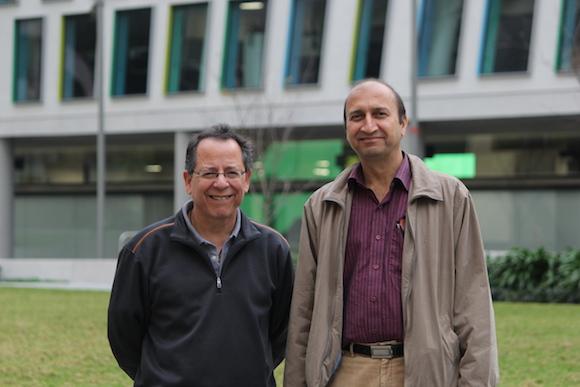Professor Krishan Kumar, from the School of Environmental Science at Jawaharlal Nehru University (JNU) in New Delhi, India visited UTS to further explore his research on urban air quality.
Kumar visited UTS a part of the Key Technology Partnerships (KTP) Visiting Fellow Program to collaborate on a research project with Professor Alfredo Huete from the Plant Functional Biology and Climate Change Cluster (C3).
Kumar and Huete are researching the air pollution climatology in the Indo-Gangetic Plains, the area which encompasses most of northern and eastern India.

UTS Professor Alfredo Huete and Professor Krishan Kumar from Jawaharlal Nehru University, India.
“There is a lot of rice and wheat-cropping systems in this region and in certain seasons there are a lot of fires, because farmers want to make their fields ready for the next crop as early as possible so they burn the crop residues, which leads to the emission of a lot of pollutants,” Kumar said
“Huete is an expert in crop phenology, so he will be able to give us great input into this research, and also help to investigate the impact of these fires.
Kumar and Huete use satellite remote sensing data to investigate the relations between bushfires, air quality and vegetation in the region.
The visit has enabled Kumar to reinvigorate the focus of his research. He was able to spend time reviewing satellite data of carbon monoxide levels across the Indo-Gangetic Plains that had been “puzzling”.
“I was able to dig out even more data, and discovered, especially in the rural areas of the eastern Indo-Gangetic Plain, cooking fuel practices, could be having an impact on the ambient CO levels.
“In rural areas, they rely upon sources such as crop residues, coal and cow-dung cake. When burnt, these fuel types release a lot of ash and carbon monoxide emissions. People in the eastern Indo-Gangetic Plain rely more on these sources, and that seems to be the reason that carbon monoxide levels are much higher in this region.”
While visiting UTS, Kumar also assisted Huete on his research with the Australian Centre for Ecological Analysis and Synthesis (ACEAS) Aerobiology Working Group, by providing wind data analysis.
Kumar believes that collaboration between researchers improves the quality of research work, and enables a scientific problem to be understood in its entirety.
“The knowledge domains of the two sides may be very different, so it’s always better to collaborate together,” Kumar said. “You will be able to produce better quality in terms of research publications and research output by collaborating with other scientists, rather than working in your own shell.”
Kumar noted that there were significant differences in the location and campus environment of UTS and JNU, he said there are similarities in the cultural diversity of the two universities.
“At JNU we have a significant number of international students and students from different parts of India, and I find the same situation at UTS as well; you’ve got students from various regions of the world. In that sense, the two institutions are quite alike.”
Kumar’s visit to UTS, has initiated a number of collaborative research projects for Kumar and Huete. They intend to focus on the South-East Asia region and research the impact of air pollutants on humans, by first studying the crop and vegetation phenology. Kumar and Huete also discussed further student exchange visits and the co-supervision of students.

